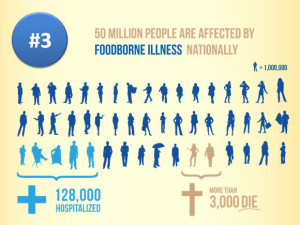Charlotte. A young, helpless girl who was thought to be a lost medical cause and a mother refusing to give up on her daughter’s life.
When it comes to uncomfortable situations, Americans seem to argue their opinions to the bone without pausing to notice the realities happening right outside their door. This becomes the issue with legalizing marijuana in this country. But how is that possible? According to Pew Research Center, 53 percent of Americans and 68 percent of millennials are in favor of the legalization of marijuana. To go even further, twenty-three states and the District of Columbia currently have laws legalizing marijuana. With such a high percentage and so many states already on board, how is it possible that it is not already written into legislation and being passed nationwide as we speak. But it dawned on me that it is possible, when people do not realize that there is so much more to this plant than just a sensation, but life saving agents hidden within as well.
Charlotte isn’t the figure we imagine when picturing the poster child for marijuana, but looks truly deceive as this little girl takes the legalizing world by storm. Her story has been not only an enlightenment, but a beacon of hope for many other families across the nation who have children suffering of untreatable illnesses. Charlotte’s illness is called Dravet Syndrome, a rare form of severe, intractable epilepsy. Intractable means the seizures are not controlled by medication and yet her mother Paige Figi refused to believe there was nothing they could do to help her daughter. She would not accept that her daughter was known, after years of medication, to be a lost cause. The Dravet Syndrome Foundation page didn’t even have any listed alternatives unless it be therapy or ketogenic diets (which Paige had already tried). But this would not be the end of her search for help.
Since Charlotte’s birth Paige was determined to find an answer. The first seizures with Charlotte came during her infancy. In the second year, only more seizures began to take hold, some seizures lasted more than 30 minutes, while others came in clusters, one after the other. No matter the treatment it seemed Charlotte would not be able to last going on like this. With over 300 seizures a week, Charlotte had become nearly catatonic.
With Charlotte’s condition only getting worse and options running slim to none in the medical world. Paige decided it would be time to search somewhere else, and that by some miracle, she would find a possible solution. With the help of her husband Matt, (and massive amounts of googling) they found the answer to their prayers. Paige was overjoyed the day they found information on what may be a miracle for their daughter “The day I gave up, I found this old data that the cannabis plant was a proven anti-convulsive.” Like many Americans before them Paige and Matt were not exactly for legalizing marijuana, but how that changed after Charlotte.
Like the Figi’s, the typical American does not think about the many positive effects that marijuana could bring about. Even today everyday people do not enjoy a discussion on the topic of marijuana because, like Trump and abortion, they are unspeakable and induce a heated fervor that many do not wish to deal with. This forms an enormous issue when speaking about marijuana because we lose focus on the pros and cons of the matter and begin to hone in more so on our own opinions brought on by sometimes untrustworthy sources.
Failing to look further than ones front door on the idea of marijuana is a mistake and allows those opposed to have a stronger voice than an agreeing majority. And once their arguments are framed, the outcome can be detrimental. Dr. Sanjay Gupta, both neurosurgeon and media reporter changed his own mind on the subject of legalizing marijuana. He interviewed the Figi family during his documentary “Weed” and came to realize the disheartening truth about marijuana in the media. “We’ve been systematically misled in this country for some time and I did part of that misleading. If you look at papers written in the U.S. on marijuana, the vast majority are on the harm. We fund studies on harm, we don’t fund studies on benefits.” This becomes such a terrible realization. Studies that could be done if the drug was made more available (legal) and save lives aren’t being done because certain entities do not want competition. When there is no funding, there can be no true progression and that should frighten us.
Once one delves a bit deeper, we can begin to see (that even though limited), the positive medical studies on marijuana are there. Dr. Robert J. DeLorenzo, of the Virginia Commonwealth University, School of Medicine did a study on marijuana and how it could help epilepsy. By using the cannabinoid in marijuana plants, it can tackle frontal lobe epilepsy and bring regularity to the patient. To me this is an incredible breakthrough and yet it is overshadowed by studies that wish to combat its legislative success. How can we allow such wonderful news to be lost in the shadows? It is weak counterarguments and a plethora of funded government studies that mask these wonderful breakthroughs. But Paige didn’t have time to wait for more studies to be taken and the info she found would have to be enough. At 5, Charlotte had reached bottom and something needed to be done.
This is when Paige decided to buy her own bag of high concentrated CBD (cannabinoid) in Denver, Colorado. She then went home and gave the first dose to Charlotte through her feeding tube, since she was no longer able to swallow. For an entire week with CBD, Charlotte had no seizures. 300 episodes had been averted. Charlotte was then able to begin her life. She began to speak, walk and learn. Charlotte was able to become the child she was meant to be because of a drug that had been so furiously refuted. Charlotte was able to live because of a drug that was supposed to help kill. Paige knew she couldn’t stop there and wanted to find a perfect strain that she could keep giving her daughter.
Once the breakthrough of CBD was found for Charlotte in that first week, Paige searched to see who would be able to produce a plant even higher in CBD and low enough in THC to deliver continuous effects. This is when she found the Stanley Brothers. They are marijuana growers in Colorado that bred hybrid plants to higher the CBD. At first they were called crazy and mocked for growing an ‘undesirable’ plant, but they had much larger plans for their business. Jesse Stanley spoke in an interview on how he and his brothers got started, “Before we met charlotte, before we met anybody, we had done our own reading and research on CBD that had shown that it stopped the metastasis of cancer, specifically breast and ovarian cancer.”
They hadn’t even met Charlotte and were already working towards strains that could help her cause. Paige reached out to the Stanley Brothers and they began to work on this strain for her daughter. The better Charlotte became the more they perfected the drug and they named it Charlotte’s Web, after its founding patient. After hearing about the amazing effects that Charlotte was having to the drug others wanted to see if this treatment could help their own children. In that year alone, 41 children in Colorado were treated with Charlotte’s Web and all came back with great news. They had all undergone positive effects from the drug. Paige could see the amazing feats that the drug had now allowed for not only her own child, but others suffering.
Paige realized what a blessing it had been that she had run into the old data that led her to meet the Stanley Brothers. But what if Paige had never encountered this old data and it had stayed buried underneath all the negative studies that were meant to be seen? What would she have done then?
It’s difficult to look back and say what if, but sometimes it is necessary for progress. Charlotte would have never been able to grow and learn the same way she did without marijuana, and yet so many fight for it to remain illegal. What needs to be done is more studies and focus on what this incredible drug can do for others. With so much wonderful breakthroughs to be reached there should be nothing holding us back.
Charlotte’s story is a clear example of people going beyond the comforts they had once believed to find a cure they didn’t even know was possible. The Stanley Brothers ignored the mockery of those from the outside and were able to create something wonderful that could better the lives of so many. It had become so much more than just marijuana, it was a way to change lives, and for Charlotte and her family, it had changed everything. Paige would continue fighting for legalization of marijuana everywhere so others suffering could obtain the drug they so desperately need. She had experienced the miracle and wouldn’t settle until others were able to make the choice to use marijuana as a treatment as she had. Paige stated “a mistake was made during prohibition and I think we can fix it.”
- The title “Why we need to revisit legalizing” pulls in the reader. They wonder what exactly needs to be legalized and why is it being revisited. It also shows that the article will have a spin and new info into why the process should be revisited. I also thought my subtitle ”Why raising awareness about the pros of marijuana use may just change the minds of skeptics everywhere” was great in supporting the main topic of my paper, which was looking to see all the positives that were being overshadowed on the subject of marijuana. The lede unlike my title focuses on my main example in the article, Charlotte. I think for those not so much interested in legalizing may be interested once they see how much is invested and that it has to do with so much more than ‘morals.’
- I enjoy my opening paragraph because it gives the reader a little bit of everything. I included statistics that brought exigency and relevance, while also putting a professional, yet sarcastic flare to the article. It addresses my point on legalizing and eludes to Charlotte and her predicament. It gives background on how the controversy has been addressed and argues how it should be handled going forward.
- I feel I did a sufficient job in bringing on evidence to support my argument. Unlike many other papers I constructed this article around Charlotte and I feel her story alongside important data is extremely important and effective. One truly feels for this family and their hardships, which wouldn’t always be captured by any article. The significance is seen through the real life effects taking place in the Figi’s lives.
- I think I had a clear conception of how to execute my paper. I created a space that both gave hard facts and delivered a heart felt story. I think it was a unique approach because unlike articles that usually tackle one subject or another, I incorporated and meshed two styles to fit my cause. This combined topics from the past but then brought forth new information, creating my article style.
- I avoided any vague or cliche points because readers of the NYT are usually proved to be more informed and educated on controversial/important topics. I had to make sure I didn’t just go the ‘we should legalize’ route, but rather the ‘we should look more in depth to what may be holding legalization back.’ This I felt made a great argument in this article and avoided issues. This also allowed for more specific detail on what needed to be written. I had to meld both topics of my paper (info and story) into one, creating a steady and organized flow.
- I thoroughly researched the topic. It was by doing this that I was able to find so much supporting evidence that I found not only scholarly journals, but also documentaries and interviews. This not only made it more current and proved exigency but also proved the importance of the topic. I was able to delve deeply into research on why people did not want it legalized and many sources revealed that it was false evidence that swayed people to obtain this decision. By demonstrating not only the pros, but also showing real effects through photos, I was able to prove just how important this subject really is.
- I took research and integrated it as the life of my paper. Without it I would not have the tools I needed to build my argument. Charlotte is my MAIN source. I feel the research on her fits both primary and secondary. The documentary I used to build data was important, but further research on CNN and “Weed” a documentary that comments on marijuana and about her situation are secondary. They compile together to form a great mix of sources. Then on top of this I added other important research that supported my argument and found reliable and genuine sources.
- I think this is what my reflection was leading up to. This is essentially what my paper was. I integrated the story and the analytical and formed my argument. With both I was able not only to form an opinion to refute, but to support it with sufficient evidence to make it plausible and relevant. I then make it easy for the reader to bring about questions on the information by raising some in my paper and then answering them later on with data.
- The coherence of my evidence with Charlotte’s story I feel truly has a way of persuading the audience. After learning about her story I wanted to go and scream legalize from the rooftops. It needed to be told so more people could understand and it sure persuades one to think twice. By including outside research and unbiased research such as Pew, i was able to tackle logos. When I brought Charlotte’s story I was able to hit the pathos of each reader. Then I brought it home by hyperlinking all the professionals in my paper so it would touch ethos and all my info would be helping one of these ideas.
- The photos I chose were interesting and relevant because they hone in on the key points of my paper. I made sure to include them in areas in which related to each. I only chose 3 photos in my article because I felt that was all that was needed. One was a photo of Charlotte near catatonic in a chair, her as a healthy child, and the plant that saved her. This was all I feel was needed to get my point across. These photos are so powerful that there was no need for excess; they spoke for themselves.
- At first I was going to go straight into Charlotte’s story. After a few edits, I realized by introducing my topic I would have more credibility or ethos if I brought them in with a lede, explained, and then jumped back. I wouldn’t have made this correction without a few read overs. Also being able to articulate both story and data was difficult and those edits became necessary when writing became less draft and more final cut. Also finding the main point to argue was a great step that we settled in class.
- I think they are effective because they are only used when necessary. For instance, my hyperlinks are only connected to professionals in my paper or research facilities. I found this important just in case the reader wanted to learn more about the topic. Another hyperlink I made was Dravet syndrome. It is not a very common illness and I felt it was helpful to add something like that to aid the reader.
- I edited this paper multiple times during the drafting process. I feel this allowed me to make sufficient grammatical and usage corrections. By doing so I was able to articulate my argument with ease and be able to work out kinks in the article. I made sure all of my transitions from data to story were smooth and didn’t leave the reader questioning or confused of what was going on. So in this sense I feel I did a good job in establishing not only my credibility, but producing a strong and hearty argument for the reader.





